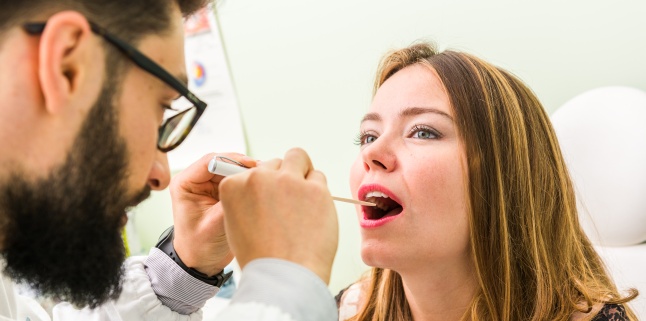What do you need to know about laryngoscopy?

Laryngoscopy is a medical examination necessary to determine certain diseases or problems in the throat, including: - persistent cough, - (bleeding cough), - hoarseness, - sore throat, - bad breath, - difficulty in swallowing, . Laryngoscopy is also used to remove foreign bodies blocked in these areas to take biopsies from normal or pathological tissues discovered during examination, to remove polyps from vocal chords, or to help with laser treatment. Because the procedure involves, you do not have to drive after laryngoscopy so consider how to get and get out of the doctor. Talk to your doctor about what to do and ask what you need to know to prepare before laryngoscopy. Depending on the type of anesthesia, the doctor will tell you to stop the food and drink intake eight hours before the procedure. If you do not need general anesthesia, there is no need to abstain from.
In most cases, laryngoscopy involves mild anesthesia, but always ask your doctor to be sure. Tell your doctor about any type of treatment you are taking. In the case of certain drugs such as or of platelet antiaggregants (clopidogrel), doctors recommend not to take one week before laryngoscopy. Before stopping any treatment, contact the doctor who prescribed it to you. Before your laryngoscopy, your doctor may submit you to further analysis to have a wider idea of the symptoms.
These analyzes may include: - Physical examination - Pulmonary radiography - - Barium test. Before radiography, the doctor may ask you to swallow a liquid called barium. This is a contrast substance that will help your doctor to better observe certain radiographic features. Barium is neither dangerous nor toxic and is removed from the system a few hours after it has been ingested. Laryngoscopy lasts between 5-45 minutes.
There are two types of laryngoscopy: direct and indirect. Indirect Laryngoscopy In the indirect method, the patient stands straight on a back seat. Apply local anesthetic in the mouth area or directly on the neck. The doctor will cover your tongue to have a better view of the area under examination. Then he will introduce a mirror to explore the area.
You will be asked to remove certain sounds (high frequency \. If you have a foreign object stuck in your throat, your doctor will remove it. Direct Laryngoscopy Direct Laryngoscopy can be performed at the hospital or at the doctor's office and assumes total anesthesia under the supervision of an anesthetist. Under total anesthesia, the patient will not feel anything during the procedure. The doctor will insert a small, flexible telescope on the nose or mouth, which will then reach the neck.
Using the telescope, the doctor will see the largials closely. Also, this telescope can collect samples and remove objects or excrescences. This procedure will be performed if you get lightly coughing, or if the doctor needs to examine areas harder to find in the larynx. Interpretation of results During laryngoscopy, the physician can collect samples, remove growths, or remove foreign objects. A biopsy can also be done if you have certain formations that raise a neoplastic suspicion.
After laryngoscopy, the doctor will discuss the results with you or will direct you to another physician. If the procedure involves, receiving the results lasts for 3-5 days. Risks and complications are usually not associated with laryngoscopy. It may be that the soft area in the neck is slightly irritated, but generally this procedure is considered safe. In direct laryngoscopy, it takes a little recovery time after.
It usually lasts two hours until it has no effect, but you will need to avoid activities such as driving. If you are worried before the procedure, talk to your doctor to inform you about the steps you should take before laryngoscopy. Larynx and vocal chords require hydration, so it's important to consume between 6-8 glasses of water a day, avoid eating, spicy foods, smoking, and frequent use of antihistamines and cold medicines. Using a humidifier to maintain a degree of 30% moisture can be helpful. .
Source : sfatulmedicului.ro
Views : 2866
Popular Article
- (photo) Nude becomes art.
Posted: 2018-03-17, 9370 views.
- The harmful effects of air conditioning on the skin
Posted: 2017-06-08, 8044 views.
- 3 causes of dyed hair discoloration
Posted: 2017-06-15, 7927 views.
- Why early puberty occurs in girls: symptoms, favors, diagnosis and treatment
Posted: 2017-10-24, 7786 views.
- Good or bad skin treatments in the hot season
Posted: 2017-06-07, 7529 views.
Recommendations
- (photo) Nude becomes art.
Posted: 2018-03-17, 9370 views.
- The harmful effects of air conditioning on the skin
Posted: 2017-06-08, 8044 views.
- 3 causes of dyed hair discoloration
Posted: 2017-06-15, 7927 views.
- Good or bad skin treatments in the hot season
Posted: 2017-06-07, 7529 views.
- Risks of practicing sports on hot days
Posted: 2017-06-12, 7112 views.
 4 effective ingredients in the fight against acne.
4 effective ingredients in the fight against acne. How to get rid of hiccups fast
How to get rid of hiccups fast The wheat bran diet: the secret of lost pounds as if by magic
The wheat bran diet: the secret of lost pounds as if by magic The recipe that will sweeten your soul this weekend!
The recipe that will sweeten your soul this weekend!  Is it dangerous or not to refreeze meat after thawing it?
Is it dangerous or not to refreeze meat after thawing it?  The unusual sign of diabetes indicated by saliva.
The unusual sign of diabetes indicated by saliva. What to drink to boost your immune system.
What to drink to boost your immune system. 10 foods that help you never age.
10 foods that help you never age. What actually happens in your body if you drink a cup of coffee for breakfast
What actually happens in your body if you drink a cup of coffee for breakfast 5 surprising benefits of chia seeds
5 surprising benefits of chia seeds